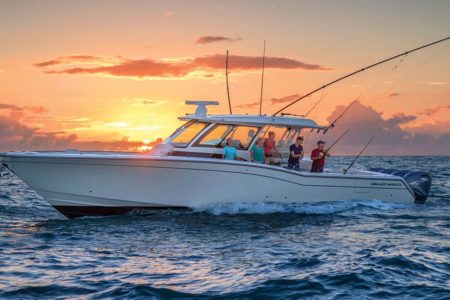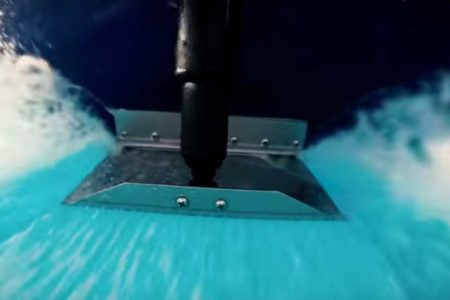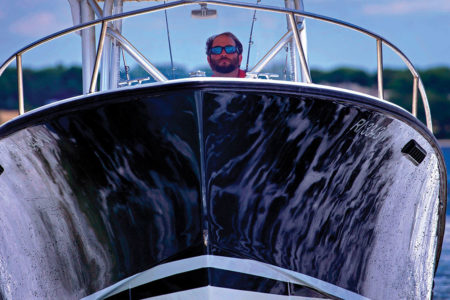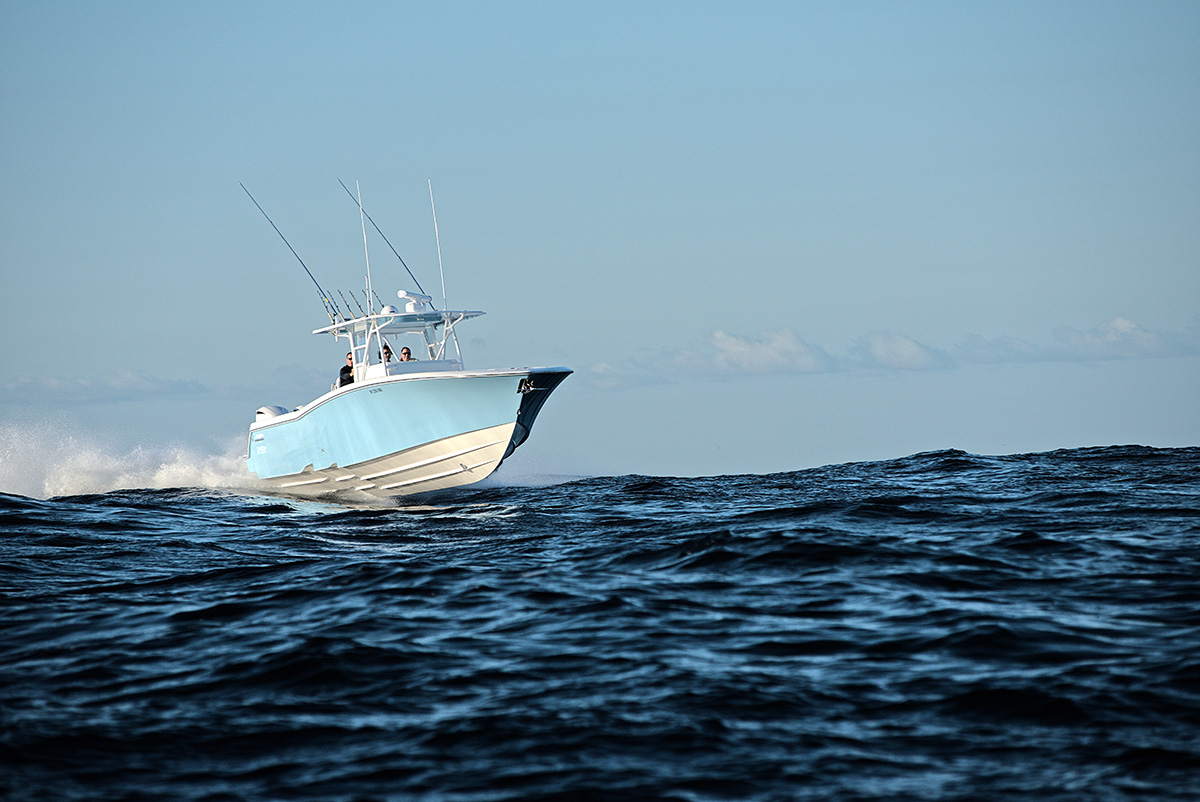
There is nothing quite like the exhilarating feeling of speeding to your favorite offshore fishing spot at 35 to 40 knots, racing the oncoming sunrise to see who gets to the 100-fathom line first. Captain and crew are alone with their thoughts in a dreamy trance contemplating the rod and reel battles to come, as the wind howls through the riggers, punctuated by the occasional “whoosh” of the deep-vee slicing through pre-dawn seas and the steady growl of a trio or quad of big-block four-strokes pushing relentlessly towards the GPS’s final destination. This is the ultimate in get-there-fast sportfishing, and you are on the right boat, at the right time and in the right place to make it happen. I have been there and done that and it’s truly a singular experience.
This Boat Sense column focuses on high performance sportfishers, which are a special breed of center console craft designed to travel great distances at high rates of speed and have the fuel capacity/range, comfort and power to get you there and back faster than the average fishing boat. High performance center consoles typically range in size from 32 to 50-plus feet in length and the majority of them are outboard powered. These boats can bridge the gap between wave crests when underway at speed, effectively neutralizing the tendency of smaller vessels to fall off of wave tops and into the troughs, creating a smoother and drier ride in the process.
Northeast anglers and their style of high performance center consoles have to travel longer distances than their southern counterparts to get to the numerous canyons that dot the 100-fathom curve from the DelMarVa all the way northeast to Gloucester, enduring constantly-changing weather patterns and shifting sea conditions many miles from shore. Although high performance sportfishers tend to have a singular look and feel, there are many traits that they all share in common.
Common Traits
Bigger is definitely better—and bigger gives you a lot more room both above decks and below to add all of the requisite fishing and comfort features that make an extended stay at your favorite canyon an eminently workable and comfortable experience. Most high performance chariots offer at least 10 to 12 hours or more of cruising range, so depending on your projected outboard power and fuel burn, fuel tanks can be anywhere from 350 to 1,000 gallons (You read that right, we’ll explain more later in the article.). If I were shopping for a high performance chariot, I would insist on at least a 12-hour cruising range or more, if that were available with optional fuel tankage from the boat builder of choice. These vessels typically have a minimum of two recirculating livewells; 1,000-quarts plus of insulated cooler capacity via either under-sole fishboxes, external coffin boxes or both; storage for at least 20 rodholders; sitting positions for at least five to six crew members; a sleeping cabin under the huge center console; plus room for two or three big-screen color multi-function displays at the expanded dash for all of your marine electronics. Tackle centers are a must, as are plenty of dry storage for all of your gear, a standup marine head and at least 30 gallons or more of freshwater capacity. Some of the larger boats in this size range take the creature comfort factor to the max with air-conditioning and even more spacious quarters down below.
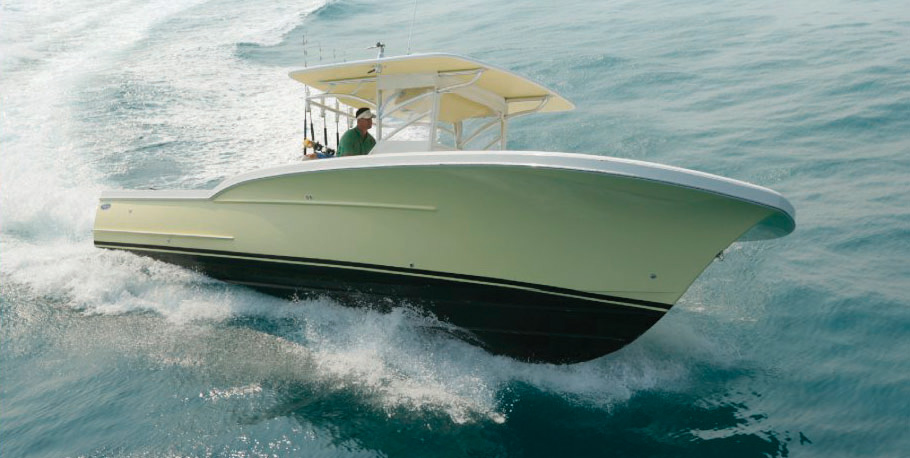
Evolution
The first generation of high performance boats introduced back in the early 1990s started to break the 30-foot barrier, with triple two-stroke outboards on mid-30-foot hulls. The vessels in this initial vanguard were racers that were converted over to fishing boats by adding a center console, a T-top and a few other requisite items like rodholders, fishboxes and livewells. Some names that come to mind from these early trend setters and opinion-shapers were Donzi, Fountain, Cigarette, Scarab and other lesser known Florida boutique boat builders. Most of these early platforms sported traditional 22- to 24-degree deep-vee running bottoms with long length-to-beam ratios of 3.5 to 1 or more. The problem with these first generation offerings were that they were not really designed from the get-go to be sport fishing boats and a lot of their hull shapes and build technology were borrowed from the race boat world with band-aid solution add-ons to appeal to anglers. Sure, they could go fast into the sea in a straight line, but didn’t have a lot of room onboard for the usual fishing gear, due to narrow beams and deck plans that were not quite fit for the task. And when you stopped to troll, drift or anchor, these running bottoms were prone to excessive amounts of rock and roll due to their unique length-to-beam ratios, and not up to the typical multi-mission specifications required by today’s bluewater fishing machines.
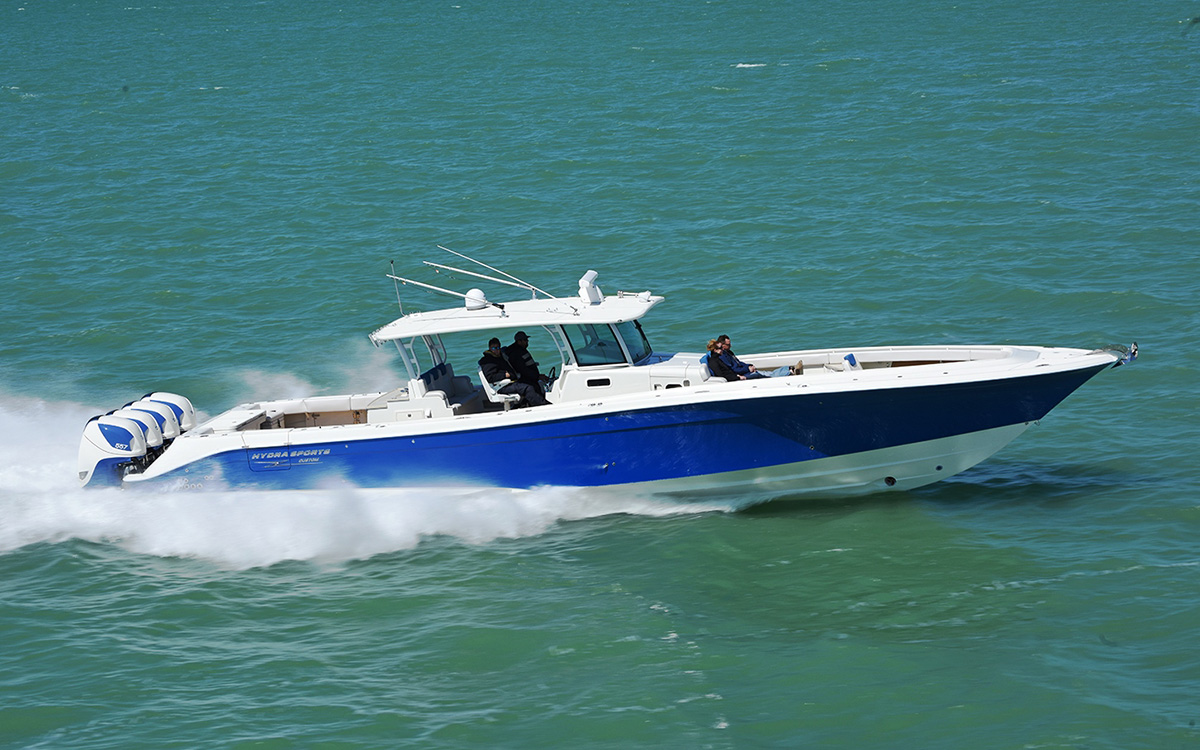
But the need for speed was firmly planted in the minds of coastal anglers who wanted to be the first ones to the faraway fishing grounds and evolution, driven by consumer demand and the birth of the SKA (Southern Kingfish Association) tournament trail, began to reshape the marketplace. At the turn of the millennium, new designs from builders like Contender, Intrepid, Donzi, Hydra-Sports, Yellowfin, Scarab, Regulator, SeaVee and others started to appear to curious onlookers on the boat show circuit, with fresh ideas and advanced hull shapes. And now that the great recession seems to be behind us, both the 40- and 50-foot barriers have been broken in rapid succession, as boat builders race to see who can be the top dog in the high performance sportfishing world.
These days, it seems that there are dozens of boat builders offering 30’+ high performance center consoles, with relatively new players coming into the market on a regular basis. One of the hottest new builders that has made its way up north is Invincible, joining some of the more traditional names like Scout, Grady-White, Boston Whaler, Pursuit, Mako, Robalo, Everglades, EdgeWater, Cobia, Key West, Jupiter, Southport, Sea Hunter, Sea Hunt, Sailfish, Pro-Line, Sportsman, Century and others who have all created their own vision of what the ultimate high performance fish boat should offer. And the big dog on the block as of this writing is Hydra-Sports Custom’s totally “killa” 53 Sueños (dream) center console, which can be powered by up to a quartet of fire-breathin’ Seven Marine 627-horsepower four-stroke outboards, with a top speed of almost 70 mph and a comfortable cruising speed of 51 mph at 0.5 mpg—that’s really moving!
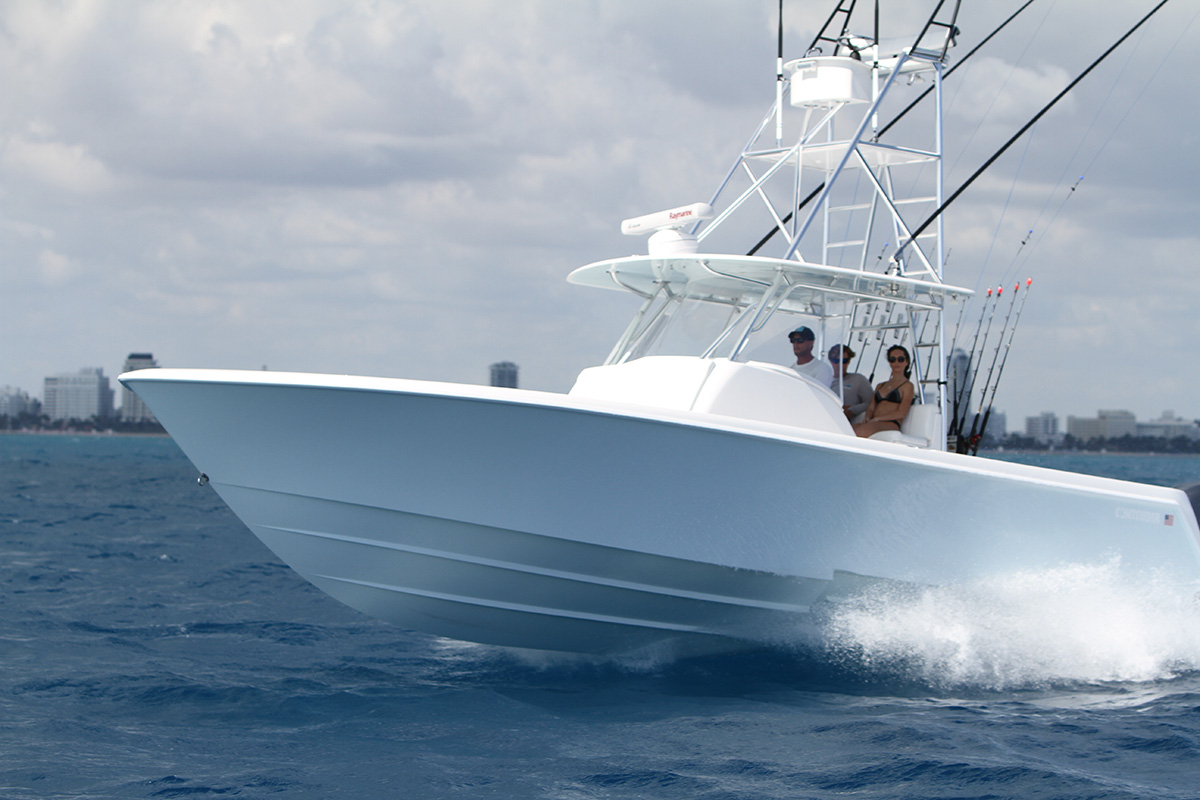
One decision that the prospective high performance center console boat buyer must make when seeking the ultimate ride is selecting his/her preferred hull design, with traditional deep-vee and stepped-vee being the two most prevalent choices. The deep-vee has been around since the early 1960s, with Ray Hunt’s and Dick Bertram’s brainchild, the 31 Bertram Moppie, but it has evolved a few generations since then. The deep-vee is a proven offshore performer, but takes a certain amount of horsepower to get that sharp deadrise running surface up on plane and to keep it running in a seaway with all of the usual bulk and weight (fuel, bait, ice, gear, etc.) associated with sport fishing boats.
The stepped-vee starts with a deep-vee hull shape, but then introduces a pair of recessed steps with side vents starting amidships and working aft that reduce friction for improved speed and fuel efficiency. The steps create less wetted surface by trapping air underneath while underway and then venting it out the hull sides. This in turn creates less overall drag, increased fuel efficiency, a softer ride and a greater top-end speed (ranging from 10 to 15 percent). But not all stepped hulls are created equally. These too have undergone a few evolutions since their introduction and depending on whose brand you prefer, they take a bit more of a learning to know how to operate in a variety of sea conditions. Some of the earlier models had issues with chine walking, excessive bow rise at certain throttle positions, or losing their aft end stability when making hard turns at speed. The latest generations have all addressed these issues, but be sure to take a long test ride in the stepped hull of your “dreams” before you find any potential nightmare scenarios.
Powerful Options
Outboard manufacturers have risen to the challenge of larger and heavier high performance chariots and are producing engines that have broken through the usual 300- and 400-horsepower barriers, with more powerful stuff that’s in the planning stages and on the not-too-distant horizon. Mercury has tweaked 300 and 350 sea ponies out of their 2.6-liter supercharged Verado in-line six-cylinder four-stroke, with a specialized 400 Racing Verado available to anyone who wants it. Yamaha has updated their big 5.3-liter V-8 power package with the new F350C version, introduced earlier this year. Suzuki’s 4.0-liter DF300 has found its way on the transom of many a 30-something sportfisher and Evinrude’s G2 300 two-stroke is a popular power option as well.
A small manufacturer located in Germantown, WI has been making a big splash in the outboard pond lately and that’s Seven Marine. Their fire breathin’ 557- and 627-horsepower V-8 outboards start off with a supercharged GM/Cadillac 6.2-liter V-8 that features 316-grade stainless steel parts at every turn, with a closed loop cooling system, a ZF marine transmission and a twin-pinion lower gearcase, tipping the scales at almost 1,100 pounds! Two of these can take the place of four of anyone else’s outboards with less bulk and overall net weight on the transom. And if you have a mechanical hiccup, concierge fix-it service is just a phone call away, but the price for one of these technological marvels is not for the faint of heart or casual boater. A pair of 557 outboards hitched to the transom of a Yellowfin 36CC will hit a top speed of 75 mph, with a fast lane cruising speed of 60 mph at 1.0 mpg and a “slow” cruising speed of 35 mph with 1.3 mpg efficiency! Translated, you can do a 65-mile canyon run in a little over an hour and burn only 65 gallons of fuel in the process—wow!
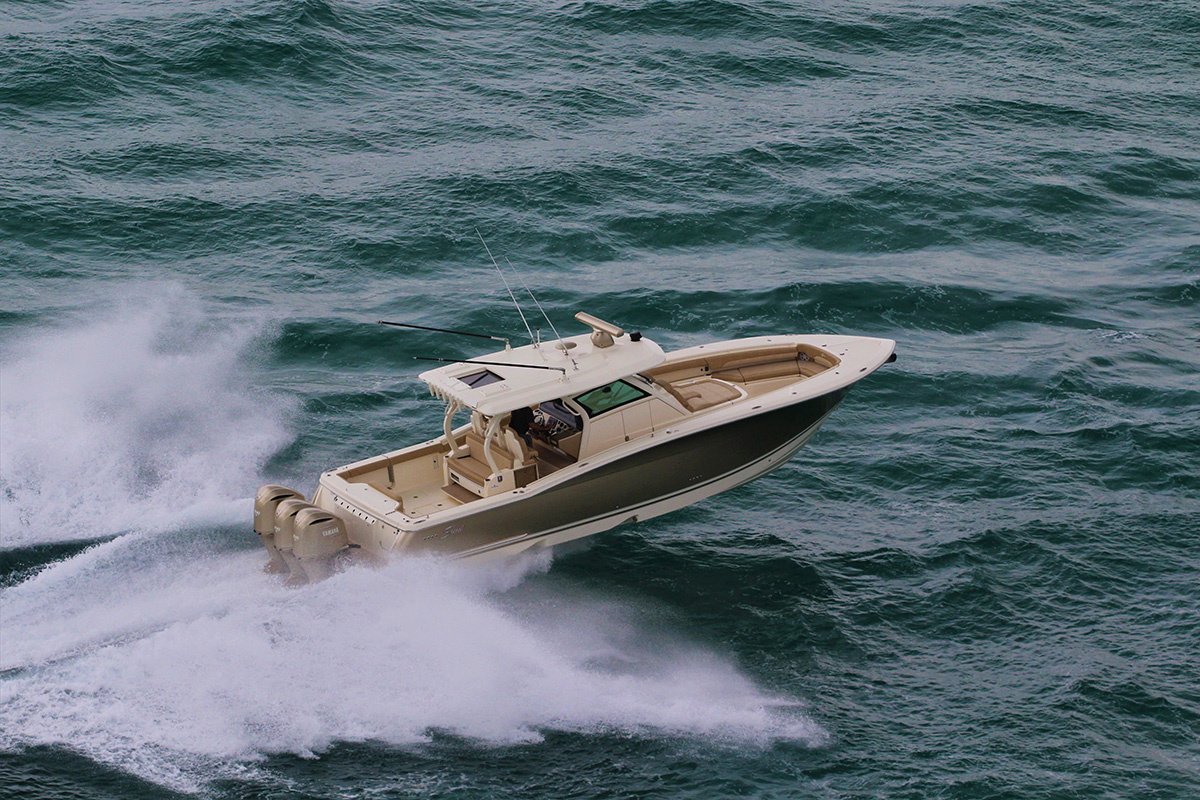
Realistic Size?
Based on the available outboard power of the day, consumer demand and existing technology, the realistic size of high performance center consoles and walkaround/fisharound cuddies has evolved from 35 feet, to 45 feet, up to 53 feet, which is where we stand now. You just know that someone out there is looking at the 60-foot barrier and licking their chops, but it’s not that simple. You just can’t take a 35-footer and turn it into a supersized 60-footer. Different stress forces are at play when you lengthen the build and weight is a factor too, even with a quartet of Seven Marine’s largest outboards pushing in excess of 2,300 sea ponies at the transom.
I spoke with Alex Leva, the president of Hydra-Sports Custom, at last fall’s Ft. Lauderdale Boat Show to get some additional insights on what it takes to build the world’s largest center console sport fishing boat. According to Alex, the 53 Sueños project required that they think out of the box for both the power side and the construction components of the project. The power side was easy, with the availability of the Seven Marine 557- and 627-horsepower outboards. With an asking price of over $110,000 per motor and a $1.8 million final price tag for the boat outfitted with quad Seven power, the cost for these outboards was almost an irrelevant factor, since HSC makes one 53CC per month and has at least a 12-month waiting list for custom build orders. Simply put, if you think it costs too much money, move over and the next rich guy in line will gladly take your place.
For the structural support side of the business, Hydra-Sports needed to enlist the services of the design team that helped create the US Navy’s Rigid Hull Inflatable Boat (RHIB) small combat craft, using a similar single-skin uncored laminate membrane hull technology. I would need 3,000 words or more to explain the numerous composite and laminate technologies and how they all interact with each other to create the rock-solid, stepped-vee running bottom that is the foundation of the 53 Sueños’s construction process. But if you want to know the specific details on how it all happens, you can read all about it by visiting www.hydrasports.com.
High performance center consoles and walkaround/fisharound designs are way cool and if you’ve never felt the wind trying to blow your hat off at 40- knots, definitely try to hook up with some of your buds and jump aboard one of these unique sport fishing platforms. It will be one of the unique thrills of your lifetime for sure!

